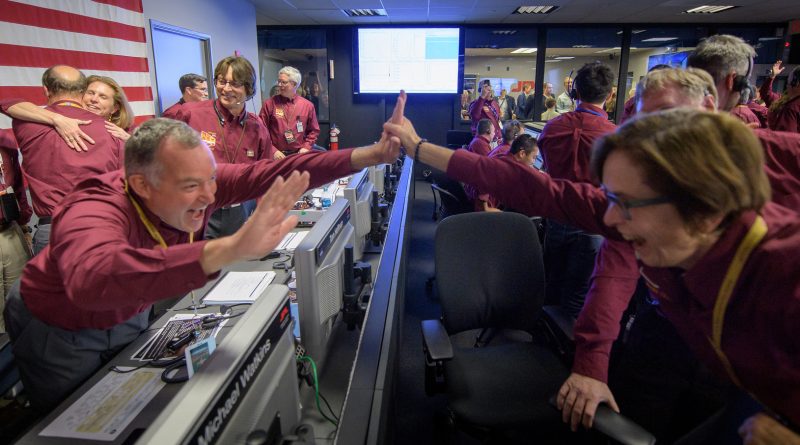NASA's InSight Lander Successfully Touches Down on Mars

Photo Credit: (NASA/Bill Ingalls)
For approximately one hour Monday, a number of members of the EDL Team (Entry, Descent, Landing) provided insights and commentary about the landing of InSight Mars Landing. This lander was launched aboard a United Launch Alliance Atlas V rocket in May 2018 along with 2 CubeSats -- MarCO A and B. The CubeSats, although not required for the mission, were able to provide quick relay of the information from InSight instead of having to wait for existing orbiters such as the Mars Reconnaissance Orbiter. The InSight mission is intended to explore the interior of Mars using a single seismometer, a temperature probe to be driven 5 meters into the surface and radio science. InSight is the first mission which is planned to remove instruments from the lander and place them on or in the planet.

Sunday afternoon, 25 November, a software update was sent with final details and adjustments for the landing program. The signals required approximately 8 minutes to travel from Earth to Mars, and responses required an additional 8 minutes to be returned. At approximately 2:47 EST Monday afternoon, 26 November InSight entered the Martian atmosphere.
"Seven Minutes of Terror"
The cruise module was released and InSight changed its orientation to have the heat shield aligned with the flight path. A few moments later due to the heating of this shield a communication blackout occurred. Shortly afterward communication was re-established and descent speeds of 2,000 meters per second, then 1,000 meters per second were reported.
A specially designed parachute, 12 meters in diameter, was reported to have deployed at 2:51 PM at an airspeed equivalent to mach 1.7 to allow sufficient time for InSight to slow to a reasonable speed before reaching the surface. Shortly after parachute deploy the two MarCO CubeSats resumed transmitting telemetry including Radar ON, Heat Shield Separation Condition, Radar Active, and Radar locked on the ground (surface).
Approximately 600 meters above the surface the lander separated from the parachute and continued its descent using 12 pulse engines which sent 'bullets' of rocket gas many times per second to assist the deceleration and maintain proper orientation of InSight.
Images From Another World

At 2:58 PM EST the first image from Insight was received and displayed on the screens at JPL. There was a lot of dust and debris on the images but after the dust settles further the lens shields will be moved out of the way. Also because of this dust which was stirred up by the descent engines the solar arrays were not immediately deployed. That was initiated a few minutes after the first image.
NASA has provided and will continue to provide photos of the InSight mission on their Flickr page.
All of us at We Report Space offer our congratulation to JPL and the InSight for a successful landing, and wish them luck on a long and fruitful study of the Red Planet.

Stunning, full color photo book covering every east coast launch spanning 2014-2015, including the first-ever powered landing of a SpaceX Falcon 9 rocket.
More Info



